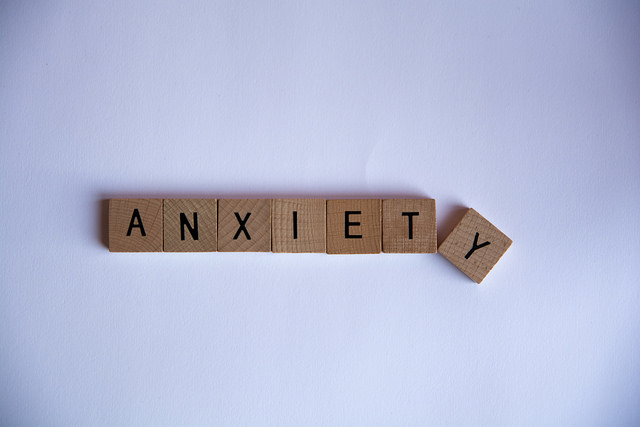18.5: Managing Public Speaking Anxiety
Learning Objectives
- Discuss common sources of public speaking anxiety.
- Identify strategies for addressing public speaking anxiety.
- Employ strategies for addressing public speaking anxiety.
If you feel fear, anxiety, or discomfort when confronted with the task of speaking in front of an audience, you are not alone. Polls consistently show that public speaking is among people’s top fears (Bodie, 2010). Yet, since we all have to engage in some form of public speaking, this is a fear that many people must face regularly. Effectively managing speaking anxiety has many positive effects on your speech. One major area that can improve with less anxiety is delivery. Although speaking anxiety is natural and normal, it can interfere with verbal and nonverbal delivery and thus make a speech less effective. In this chapter, we explore some causes of speaking anxiety, ways to address it, and best practices of vocal and physical delivery.
Sources of Speaking Anxiety

Decades of research conducted by communication scholars shows that communication apprehension (towards multiple forms of communication, not just public speaking) is common among college students — in fact, about seventy percent of students report suffering from that (Priem & Solomon, 2009).
Public speaking anxiety is a type of CA that produces physiological, cognitive, and behavioral reactions in people when faced with a real or imagined presentation (Bodie, 2010). Physiological responses to public speaking anxiety include increased heart rate, flushing of the skin or face, and sweaty palms — the result of natural chemical processes in the human body. The fight or flight instinct helped early humans survive threatening situations: when faced with a tiger, for instance, the body released adrenaline, cortisol, and other hormones that increased heart rate and blood pressure to get more energy to the brain, organs, and muscles in order to respond to the threat. Our physiology hasn’t caught up with our new ways of life. Our body doesn’t distinguish between the causes of stressful situations, so facing an audience may release the same hormones as facing a wild beast.
Cognitive reactions to public speaking anxiety often include intrusive thoughts that can increase anxiety: “People are judging me,” “I’m not going to do well,” and “I’m going to forget what to say.” These thoughts are reactions to the physiological changes in the body but also bring in the social/public aspect of public speaking: speakers fear being negatively judged or evaluated because of their anxiety. Such thoughts may lead speakers to stop and return to their seat or leave the classroom. Anticipating these reactions can also lead to avoidance behavior, where people intentionally avoid situations where they will have to speak in public.
Addressing Public Speaking Anxiety
While we can’t stop the innate physiological reactions related to anxiety from occurring, we do have some control over how we cognitively process them and the behaviors that result. Research on public speaking anxiety has focused on three key ways to address this common issue: systematic desensitization, cognitive restructuring, and skills training (Bodie, 2010). In addition, it is important to address the physical manifestations of speaking anxiety.
Systematic Desensitization
Systematic desensitization refers to the fact that we become less anxious about something when we are exposed to it more often (Bodie, 2010). The novelty and uncertainty of public speaking causes anxiety in many people. Becoming more familiar with public speaking by doing it more often can logically reduce the novelty and uncertainty of it.
Systematic desensitization can result from imagined or real exposure to anxiety-inducing scenarios. In some cases, an instructor leads a person through a series of relaxation techniques. Once relaxed, the person is asked to imagine a series of scenarios, including speech/ presentation preparation and delivery. This is something you could also try to do on your own. Imagine yourself going through the process of preparing and practicing a speech/ presentation, then delivering it, and then returning to your seat, which concludes the scenario. Aside from this imagined exposure to speaking situations, taking a communication course like this one is a great way to directly engage in systematic desensitization. Most students report that they have less speaking anxiety at the end of a semester than when they started, which is at least partially due to the fact they were forced to engage with speaking more than they would have done if they weren’t taking classes and didn’t have to deliver a presentation at any point.
Cognitive Restructuring

Cognitive restructuring entails changing the way we think about something. A first step in restructuring how we deal with public speaking anxiety is to cognitively process through our fears to realize that many of the thoughts associated with public speaking anxiety are irrational (Allen, Hunter & Donohue, 2009). For example, people report a fear of public speaking over a fear of snakes, heights, financial ruin, or even death. It’s irrational to think that the consequences of giving a speech in public are more dire than getting bitten by a rattlesnake, falling off a building, or dying. People fear being evaluated negatively, but most audiences in fact overlook or do not even notice many errors that we, as speakers, may dwell on. Once we realize that the potential negative consequences of giving a speech are not as dire as we think they are, we can move on to other cognitive restructuring strategies.
Communication-orientation modification therapy (COM therapy) is a type of cognitive restructuring that encourages people to think of public speaking as a conversation rather than a performance (Motley, 2009). Many people have a performance-based view of public speaking. This can easily be seen in the language that some students use to discuss public speaking. They say that they “rehearse” their speech/ presentation, deal with “stage fright,” then “perform” in front of an audience. There is, however, no stage at the front of our classroom — or in most workplaces. To move away from a performance orientation, we can reword the previous statements to say that we “practice” speeches/presentations, deal with “public speaking anxiety,” then “deliver” speeches/presentations from the front of the room. Viewing public speaking as a conversation also helps with confidence. After all, you obviously have some conversation skills, or you wouldn’t have made it to college. We engage in conversations every day. We don’t have to write everything we are going to say on a note card, we don’t usually get nervous or anxious in regular conversations, and we are usually successful when we try. Thinking of public speaking as a type of conversation helps you realize that you already have accumulated experiences and skills that you can draw from, so you aren’t starting from scratch.
Last, positive visualization is another way to engage in cognitive restructuring. Speaking anxiety often leads people to view public speaking negatively. They are more likely to judge a speech they gave negatively, even if it was good. They are also likely to set up negative self-fulfilling prophecies that might hinder their performance in future speeches. To effectively use positive visualization, it’s best to engage first in some relaxation exercises such as deep breathing or stretching, which we will discuss more later, and then play through vivid images in your mind of giving a successful speech. This should be done a few times before giving the actual speech. Students sometimes question the power of positive visualization, thinking that it sounds corny, but people such as Olympic athletes do it all the time. Try it to see if it works for you.
Skills Training
Skills training is a strategy for managing public speaking anxiety that focuses on learning skills that will improve specific speaking behaviors. These skills may relate to any part of the speech-making process, including topic selection, research and organization, delivery, and self-evaluation. Skills training, like systematic desensitization, makes the public speaking process more familiar, which lessens uncertainty. In addition, targeting specific areas and then improving on them builds more confidence, which can in turn lead to more improvement. Feedback is important to initiate and maintain this positive cycle of improvement. You can use the constructive criticism that you get from your instructor and peers in this class to target specific areas of improvement. Self-evaluation is also an important part of skills training. Make sure to evaluate yourself within the context of your assignment or job and the expectations for the speech/ presentation. Don’t get sidetracked by a small delivery error if the expectations for content far outweigh the expectations for delivery. Combine your self-evaluation with the feedback from your instructor, boss, and/or peers to set specific and measurable goals and then assess whether or not you meet them in subsequent experiences. Once you achieve a goal, mark it off your list and use it as a confidence booster. If you don’t achieve a goal, figure out why and adjust your strategies to meet it in the future.
Physical Relaxation Exercises
Suggestions for managing speaking anxiety typically address its cognitive and behavioral components, while the physical components are left unattended. As we learned earlier, we can’t block these natural and instinctual responses. We can, however, engage in physical relaxation exercises to counteract the general physical signs of anxiety caused by cortisol and adrenaline release, which include increased heart rate, trembling, flushing, high blood pressure, and speech disfluency.

Some breathing and stretching exercises release endorphins, which are your body’s natural antidote to stress hormones. Deep breathing is a proven way to release endorphins. It also provides a general sense of relaxation and can be done discretely, even while waiting to speak. In order to get the benefits of deep breathing, you must breathe into your diaphragm. The diaphragm is the muscle below your lungs that helps you breathe and stand up straight, which makes it a good muscle for a speaker to exercise. To start, breathe in slowly through your nose, filling the bottom parts of your lungs up with air. Hold the breath for three to five full seconds and then let it out slowly through your mouth. After doing this a few times, many students report that they can actually feel a flooding of endorphins, which creates a brief “light-headed” feeling. Once you have practiced and are comfortable with the technique, you can do this before you start your speech/ presentation, and no one sitting around you will even notice. You might also want to try this technique during other stressful situations. Deep breathing before dealing with an angry customer can help you relax and focus.
Stretching is another way to quickly and effectively release endorphins. Very old exercise traditions like yoga, tai chi, and Pilates teach the idea that stretching is a key component of having a healthy mind and spirit. Simple and discrete stretches can energize us and makeus feel more balanced and relaxed. Our blood and our energy/stress have a tendency to pool in our legs, especially while sitting. The following stretch can help manage the physical manifestations of anxiety while waiting to speak. Start with both feet flat on the floor. Raise your heels off the floor and flex and release your calf muscles. You can flex and release your calves once before putting your heels back down and repeating, or you can flex a few times on each repetition. Doing this three to five times should sufficiently get your blood and energy moving around. Stretching your wrists can also help move energy around in your upper body, since our huge amounts of typing and using other electronic devices put a lot of stress on this intersection of muscles, tendons, and bones. Point one hand up at the wrist joint, like you’re waving at someone. Then use your other hand to pull, gently, the hand that’s pointing up back toward your elbow. Stop pulling once you feel some tension. Hold the hand there for a few seconds and release. Then point the hand down at the wrist joint like you’re pointing at something on the floor, and use the other hand to push the hand back toward your elbow. Again, stop pushing when you feel the tension, hold the stretch for a few seconds, and release. You can often do this stretch discretely as well while waiting to speak.
Vocal Warm-Up Exercises
Vocal warm-up exercises are a good way to warm up your face and mouth muscles, which can help prevent some of the fluency issues that occur when speaking. Newscasters, singers, and other professional speakers use vocal warm-ups. Below you can see a list of warm-ups with specific words and exercises meant for different muscles and different aspects of your voice. After going through just a few, you should be able to feel the blood circulating in your face muscles more. It’s a surprisingly good workout! Such exercises can be difficult to do if you are not in a private space before your speech/presentation, but doing them at home before practicing your speech/presentation can still prove helpful.
Sample Vocal Warm-Ups
- Purse your lips together and make a motorboat sound. Hold it for ten seconds and repeat. “BBBBBBBBBBBBBBBBBBBBBBBBBBB.”
- Clench your teeth and say, “N, N, N, N,” to stretch your cheek muscles.
- Say “Mum” five times, and open your mouth and eyes wide each time you say it.
- Say “Puh” five times, making sure to use your diaphragm to enunciate the h.
- Say “Red Rover” ten times, overenunciating each r.
- Say “Wilbur” ten times, overenunciating the w and r.
- Say “Bumblebee” ten times, enunciating each b.
- Say “Red letter, yellow letter” five times, making sure to distinctly pronounce each word.
- Say “Selfish shellfish” five times, making sure to distinctly pronounce each word.
- Say “Unique New York” five times, enunciating the q and k.
Checklist: Reducing Speaking Anxiety
- You are not alone. Public speaking anxiety is common, so don’t ignore it—confront it.
- Audiences are forgiving and understanding.
- It always feels worse than it looks.
- Take deep breaths. That releases endorphins, which naturally fight the adrenaline that causes anxiety.
- Look the part. Dress professionally to enhance confidence.
- Channel your nervousness into positive energy and motivation.
- Start your outline and research early. Better information = higher confidence.
- Practice and get feedback from a trusted colleague.
- Visualize success through positive thinking.
- Practice as much as possible.
 Spotlight: “Getting Critical”
Spotlight: “Getting Critical”
How Much Emphasis Should We Place on Delivery?
Before you read the rest of the chapter, take some time to think about the balance between the value of content and delivery in a speech/presentation. We know it’s important to have solid content and to have an engaging and smooth delivery to convey that content, but how should each category be weighted and evaluated? Most people who have made it to college can put the time and effort into following assignment guidelines to put together a well-researched and well-organized speech/presentation. But some people are naturally better at delivering speeches than others. Some people are more extroverted, experience less public speaking anxiety, and are naturally more charismatic than others. Sometimes a person’s delivery and charisma might distract an audience away from critically evaluating the content of their speech. Charismatic and well-liked celebrities and athletes, for example, often endorse products and sell things to the public. We may follow their advice because we like them, instead of basing our choice on their facts or content. In today’s celebrity culture, the bling or packaging is sometimes more valued than the contents. This leads us to some questions that might help us unpack the sometimes tricky relationship between content and delivery.
Self-reflection and critical thinking questions:
- Do you think worries about content or delivery contribute more to speaking anxiety? Explain your choice.
- How should someone be evaluated who works hard to research, organize, and write a speech but doesn’t take the time to practice to ensure a good delivery? What if that person practices but still offers a poor delivery?
- How should we evaluate a speaker who delivers an engaging speech that gets the audience laughing and earns a big round of applause but does not verbally cite sources or present well-organized ideas?
- Is it ethical for speakers to use their natural charisma or speaking abilities to win over an audience rather than relying on the merit and strength of their speech content? In what speaking situations would this be more acceptable? Less acceptable?
Key Takeaways
- Getting integrated: Public speaking anxiety is a form of communication apprehension (CA) that is commonly experienced by many people and can be effectively managed using a variety of strategies. While we most often think of public speaking anxiety as an issue in the classroom and workplace, it can affect communication in personal and civic contexts as well.
- Systematic desensitization helps lessen public speaking anxiety through repeated exposure to real or imagined public speaking scenarios.
- Cognitive restructuring addresses public speaking by replacing negative thoughts with more positive thoughts, and COM therapy can help us view public speaking as a conversation rather than a performance.
- Skills training allows us to focus on improving specific skills related to public speaking, which can increase confidence and lead to further skill development.
- Physical relaxation exercises like deep breathing and stretching allow us to voluntarily use our bodies to address involuntary bodily reactions to anxiety.
Exercises
- Test your speaking anxiety using McCroskey’s “Personal Report of Public Speaking Anxiety” (PRPSA). Follow the instructions to determine your score. Do you agree with the result? Why/ why not?
- Of the strategies for managing public speaking anxiety listed in the chapter (systematic desensitization, cognitive restructuring, skills training, physical relaxation exercises), which do you think would be most useful for you and why?
- When you take a communication course like this one, you are automatically engaging in some skills training. What are some public speaking skills that you are already good at? What are some skills that you should work on? Write out three public speaking goals you would like to accomplish through your upcoming presentation.
References
Allen, M., Hunter, J. E., & Donohue, W. A. (2009). Meta-analysis of self-report data on the effectiveness of public speaking anxiety treatment techniques. Communication Education 38(1), 54–76.
Bodie, G. D. (2010). A racing heart, rattling knees, and ruminative thoughts: Defining, explaining, and treating public speaking anxiety. Communication Education 59(1), 70-105.
Motley, M. T. (2009). COM Therapy. In J. A. Daly, J. C. McCroskey, J. Ayres, T. Hopf, and D. M. Ayers Sonandre (Eds.), Avoiding communication: Shyness, reticence, and communication apprehension (pp. 379-400). Hampton Press.
Priem, J. S., & Solomon, D. H. (2009). Comforting apprehensive communicators: The effects of reappraisal and distraction on cortisol levels among students in a public speaking class. Communication Quarterly 57(3), 259-81.

